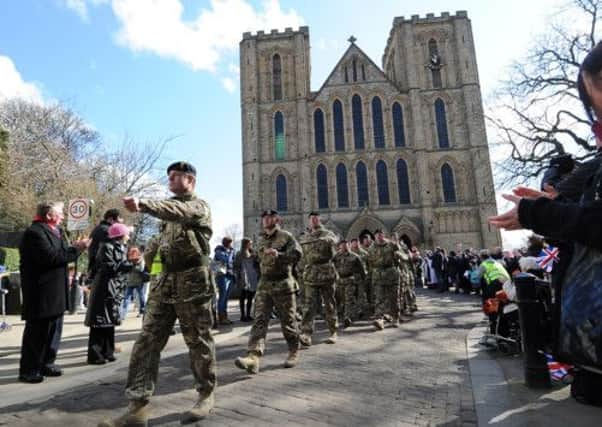Malcolm Barker: March of history as city gets ready to say another goodbye


For more than a hundred years it has been a garrison city, with the echo of marching feet – “’eft, right,’eft” – as familiar as the lugubrious sounds made by the city’s Hornblower as he sets the night watch.
Philip Hammond, the Defence Secretary, has now announced changes that mean the removal of 21 Engineer Regiment from Ripon to Catterick, probably in 2017. This drew an immediate response from the Bishop of Ripon and Leeds, the Rt Rev John Packer, who said in the House of Lords that “the damage to Ripon by the closure of Claro Barracks will be substantial in terms of the economic effect, friendships and the pride of the city” – an assertion that was self-evident during Wednesday’s poignant parade through Ripon by soldiers returning from Afghanistan.
Advertisement
Hide AdAdvertisement
Hide AdThe Bishop was undoubtedly correct. Ripon has thrived on its military connection since 1914, when Lord Kitchener, the Secretary for War, chose it as a site for training volunteers who responded by the tens of thousands to his recruiting poster. The response of the Mayor of Ripon was to declare that the city “with its charms and old-world associations is going to be, to a great extent, a thing of the past”.
He may have had the idea that the city’s good order would be disrupted by uproarious and maybe licentious soldiery. It did not quite work out like that. During the “occupation”, two whole years went by without a single case of drunkenness being brought before the magistrates.
The first arrivals, in 1915, were the Leeds Pals, the 15th Battalion, the West Yorkshire Regiment, who had been undergoing basic training above Colsterdale. After honing their skills in a newly-built camp at Ripon, they went out to Egypt, then to France, where they were virtually annihilated on the first day of the Somme, July 1, 1916.
Kitchener’s camp was a huge undertaking, served by a light railway and involving the construction of 20 miles of roads. By 1917 there were about 70,000 soldiers there, including the Highland Brigade, the Black Watch and the Gordons.
Advertisement
Hide AdAdvertisement
Hide AdThe city’s tradesfolk prospered as never before. One estimate put the troops’ collective spending power at £9,000 a week, or more than £650,000 in today’s money. After the Armistice in 1918, Ripon became one of the chief demobilisation camps, but gradually it emptied, and much of the land it occupied was restored to its original condition.
But the military never withdrew completely, and the 1939-45 war saw the arrival of the Royal Engineers in 1940. Claro Barracks, named after the old wapentake, is a substantial development, with accommodation for 277 service families and 601 single soldiers. As recently as last month, the Ministry of Defence undertook to spend a further £200.000 on improvements in the next financial year. But then came Mr Hammond, and his announcement of closure.
Ripon has already sustained other serious losses, among them the city campus of the College of Ripon and York St John. This had its origin in two teacher-training colleges set up in York in the 19th century, one for men and the other for women, before the women’s college moved to Ripon in 1862. They joined forces again in 1974, but Ripon was the eventual loser, for between 1999 and 2001 all activities were transferred to York, where the successor is York St John University.
A more recent loss was the Ripon Cathedral Choir School, which closed in January this year. Educationally, though, the city has managed to retain a most wonderful institution, Ripon Grammar School, dating back to 1555, and still thriving. It stands as a beacon among the mediocrity of comprehensives, for it is a genuine old-fashioned selective state secondary school, co-educational since 1962, and with a specialist engineering college.
Advertisement
Hide AdAdvertisement
Hide AdIt is one of the best-performing state schools in the North, rated “outstanding” in an Ofsted report last year. Its selective status was ratified in the year 2002, when parents voted 1,493 to 747 in favour. More evidence of local support came when 12 months of fund-raising yielded £1m for a new sports hall, entirely made up of donations from parents and members of the local community.
Industries have also tended to come and go. Ripon was once famous for manufacturing spurs of the very best quality, hence the saying, “as true steel as Ripon rowls”, these being the small spiked wheels attached to spurs. They are no longer made in the city, but one wonderful survivor is the firm of T and R Williamson, opened in 1775 as the first maker of varnish in the country. Daniel Williamson, its founder, was said to have learned the secret of the manufacturing process from a French refugee he befriended.
The firm’s name is still blazoned on a building close to Borrage Bridge on the way from Leeds. It has been turned into apartments, but Williamsons still flourishes elsewhere in the city.
Ripon’s greatest architectural possession is, of course, its cathedral. Below its soaring structure is a much more humble place of worship, Bishop Wilfrid’s Saxon crypt, measuring only eight feet by 11 feet under its barrel roof. In this holy place, sanctified by more than 12 centuries of praise and thanksgiving, peace and contentment prevail. Here, enshrined in ancient stones, is the very soul of Ripon.